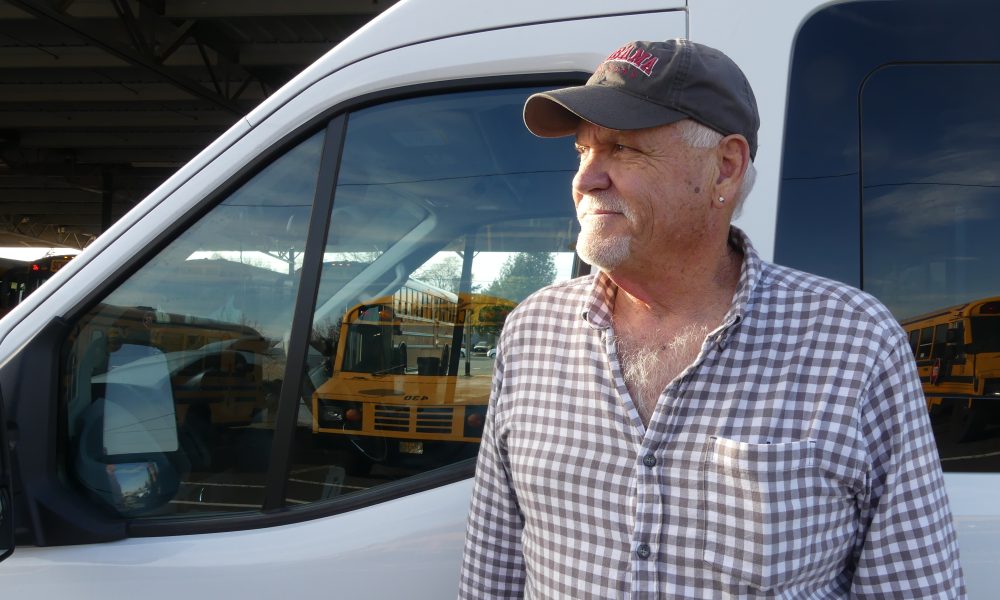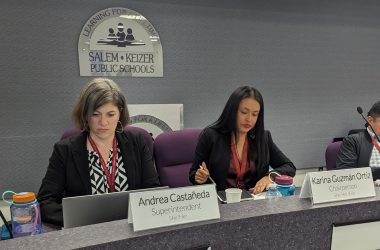
Bus driver John Svendsen stands outside the white van he drives. His four-hour route transports six homeless students from schools in Dallas, Monmouth and Independence to Salem. (Rachel Alexander/Salem Reporter)
John Svendsen’s bus route is unusually quiet.
The veteran Salem-Keizer School District driver starts his afternoon route at the main bus lot on Hawthorne Road, then drives across the bridge to west Salem. He leaves town on Highway 22, continuing west past a golf course and farmland until he turns south.
He’s alone until he reaches Monmouth, where he picks up his first student at school.
Svendsen’s four-hour route usually serves six students who live in Salem but attend schools in smaller cities in Polk County.
His charges are either homeless or in danger of becoming so, some living “doubled up” with other relatives or friends.
The group includes students from elementary to high school. They’re polite, he said, but reserved on their ride home.
“I sense that they don’t really like to talk about their home life,” Svendsen said.
As the number of homeless students in Oregon has grown, districts are struggling to keep up. In the past five years, Salem-Keizer has seen a 25 percent increase in homeless students, with 1,065 last year, according to state data. That’s about 2.5 percent of the Salem-Keizer student body.
This year, the district is on track to surpass that number, said Julie Conn-Johnson, program assistant for Salem-Keizer’s Students in Transition Educational Program, which serves those students.
Last year, Salem-Keizer spent $394,000 on transportation alone for homeless students, and another $296,000 on other services – mostly staff to help students stay in school and monitor their progress.
The bulk of that money is out of federal funds earmarked for schools with a high percentage of low-income students. School districts must use a portion of that money to serve homeless students, but funding stays flat even if the number of homeless students grows.
Conn-Johnson anticipates Salem-Keizer will be working with 1,100 to 1,300 homeless students by the end of the school year.
Most have some sort of roof over their head, but that roof is often uncertain.
About three-quarters are living with another family, friend or otherwise crowded into someone else’s home because the students or their parents can’t afford a place of their own.
And they may move around frequently.
“If they’re doubled up, they’re subject to the whims of who they’re doubled up with,” Conn-Johnson said. “Some might be there all year and some might move 15 times.”
Across Oregon, there were 21,756 homeless students last year, up from 18,902 five years ago.
While large districts like Salem-Keizer have the highest number of homeless students, it’s usually rural districts that have the greatest percentage. In Mapleton, a district of 167 students west of Eugene, one out of three students last year were homeless.
Last year, about 50 Salem-Keizer students were living in shelters, and about 60 were unsheltered, according to state data.
Federal law requires school districts to, when practical, keep students enrolled in the school they were attending when they became homeless.
The goal is to minimize disrupting their schooling at a time when much of their life is in flux.
“Students lose educational ground every time they change schools,” Conn-Johnson said. “We’d like to maintain that stability.”
The law also requires the district to transport students to their school even if they are forced to live elsewhere by circumstances.
Of the roughly 700 students Salem-Keizer now serves, about 400 live along a regular bus route or walking path.
But about 300 rely on special bus routes like the one Svendsen drives.
It’s not unusual for them to live outside the district. Drivers are now transporting students to Salem-Keizer from Albany, Corvallis, Molalla and Stayton.
“We try not to do the Portland-Beaverton thing,” Conn-Johnson said. If a student is living there longer-term, they often opt to enroll in a local school.
But it’s not uncommon for a student who’s moving around to spend a few days in the Portland area, which means Salem bus drivers make a special run. If it’s in the student’s best interest to make the commute, the school districts have to figure it out.
“They just move around and we accommodate,” Svendsen said.
He tries to get parents’ cell numbers and contact information early in the year so they can reach out if plans change. When he knows a student isn’t riding the bus for a day, he’ll change his route accordingly.
Students often switch locations mid-year as they move between shelters or find a new place to stay. Routers in the transportation department add new routes or modify existing ones accordingly.
“We’re always re-routing,” Svendsen said.
When possible, Salem-Keizer shares the commute with other districts. Svendsen’s passengers are students attending school elsewhere but living in Salem temporarily. He takes them home in the afternoon, but their morning ride is provided by the districts they attend.
The white van he drives is one of three Salem-Keizer owns for these routes so drivers aren’t taking a yellow bus for just a few students.
Conn-Johnson said the underlying problem for many families is affording a home. An increase in rent can be too much for a family that’s barely covering living expenses.
“Many of our families are working,” she said. “They’re okay until somebody sells their house or apartment building.”
The official state count of homeless students only includes those who seek help from their school district.
“There are many that we don’t know about,” Conn-Johnson said.
Reporter Rachel Alexander: (503) 575-1241 or [email protected]
Correction: This story was updated to correct Julie Conn-Johnson’s title.

Rachel Alexander is Salem Reporter’s managing editor. She joined Salem Reporter when it was founded in 2018 and covers city news, education, nonprofits and a little bit of everything else. She’s been a journalist in Oregon and Washington for a decade. Outside of work, she’s a skater and board member with Salem’s Cherry City Roller Derby and can often be found with her nose buried in a book.









